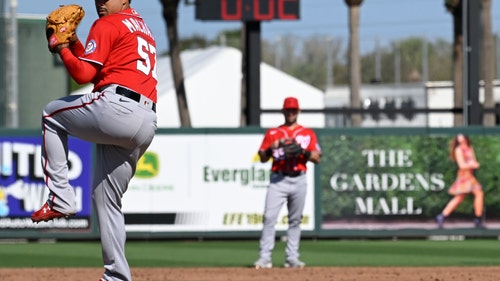
Mets' Kodai Senga making strong case for Cy Young and Rookie of the Year
On an early afternoon in mid-February, it was already 80 degrees by the time Kodai Senga ambled over to the mound to throw his first bullpen session of Mets spring training. It was clear, as Senga wiped the sweat from his brow and readjusted his clinging No. 34 jersey, that he was still acclimating to the Port St. Lucie heat. The temperature, though, seemed like the least of his concerns.
The mound was steeper than the hill he was accustomed to in Japan. The ball was smaller and not as tacky as the one he deployed in the Nippon Professional Baseball League. Those differences led to a partially messy first bullpen. Senga's patented forkball — a splitter with a big downward and deceiving break — kept dropping into the dirt in front of his squatting catcher.
Other times, his pitches would drift too far, eliciting a chest-tap from Senga that signaled, "my bad." He also needed more time between pitches than the impending pitch clock would allow.
All the while, Senga had an audience. That part, at least, he was used to. More than a dozen reporters and photographers stood behind the railing closest to his mound and watched as the newest member of the Mets' then-flashy rotation twirled forkball after fastball after cutter after forkball. A few feet behind Senga, pitching coach Jeremy Hefner supervised while teammate Adam Ottavino appeared to be looking on in admiration.
As imperfect as that first bullpen was — Senga himself described the session as "so-so" — the ceiling for what the 30-year-old Japanese right-hander could accomplish in Major League Baseball remained steep. The potential for Senga to do something big, be successful in New York, was high. Still, in an all-veteran rotation that featured Justin Verlander, Max Scherzer, José Quintana and Carlos Carrasco, we didn't really know what to expect from the rookie Senga. Over the next seven months, he has answered those unknowns.
In fact, with fewer than two weeks remaining in the regular season, Senga has a strong case for two awards that you might have heard of: Rookie of the Year and Cy Young.
Heading into Wednesday's start against the Marlins, Senga's 2.95 ERA ranks third in the National League. His 11.07 strikeouts per nine innings, 0.81 home runs per nine innings and .203 batting average against all rank fourth. He's allowed the second-fewest home runs among qualified pitchers. His 1.21 WHIP is tied for ninth. The Mets rookie has also proven he's cool under pressure and excellent at pitching out of jams, with a strand rate of 79% that ranks second in the league and fourth in the majors.
"Just because I don't feel good or I'm not feeling my best doesn't mean I just fold and give up the game," Senga recently told reporters through interpreter Hiro Fujiwara. "I'm given four or five days to prepare for this game, and I think it's my job to stay out there and make the game winnable. And I take pride in that."
Sure, Senga hasn't pitched nearly as many innings (155.1) as MLB leader Logan Webb (201), largely because he often pitches on five days of rest rather than the typical four. (The Mets attempted to acclimate Senga to four, but the results just weren't as good. In Japan, he pitched once a week.) His fewer innings compared to other Cy Young contenders could be a deciding factor, but they're not enough to exclude him from the conversation.
Senga's 4.3 bWAR ranks third among NL pitchers and his 3.5 fWAR narrowly trails Cy Young front-runner Blake Snell.
The Mets righty has a deep arsenal of six pitches, but give full credit to his ghost fork for wreaking havoc across the league this year. Senga has struck out 104 batters with his forkball across 27 starts, the tantalizing pitch producing a 60% whiff rate and 28.3% putaway rate. It's an elite swing-and-miss pitch that has made even the best hitters in the game look silly all year. To really put the domination of the ghost fork into perspective, out of the 648 batters Senga has faced this year, not one has homered off that pitch.
Moreover, Senga's 191 strikeouts rank eighth in the NL and are nearly twice as many as the league's next rookie. At his current pace, he'll finish with one of the 10-most prolific strikeout seasons by a rookie over the past 100 years.
"I think he is Rookie of the Year for what he has done this year," Mets shortstop Francisco Lindor said.
Diamondbacks outfielder Corbin Carroll has been the front-runner for the award nearly all season, and he got the chance to face Senga both in early July and last week at Citi Field. In six battles between the star rookies, Senga won five times. In their July matchup, Carroll went 1-for-3 with two strikeouts. Last week, Carroll went 0-for-3 against Senga, including a whiff on — you guessed it — the filthy forkball.
From the temperature to higher mounds to slicker baseballs, from fewer days of rest to learning multiple new languages, Senga was forced to adjust to many aspects of the game this season — not to mention expectations for his own team. The Japanese hurler signed with the Mets over other big-league suitors in part because he believed — as many did — that they had a great chance to win the World Series. That won't happen this year, but through their shared patience, the Mets now have a new ace. At season's end, he's firmly in the conversation to win not one but two prestigious MLB honors.
It's a far cry from how Senga described that first bullpen in the big leagues back in February. "So-so"? More like so, so good.
Deesha Thosar is an MLB writer for FOX Sports. She previously covered the Mets as a beat reporter for the New York Daily News. The daughter of Indian immigrants, Deesha grew up on Long Island and now lives in Queens. Follow her on Twitter at @DeeshaThosar.










